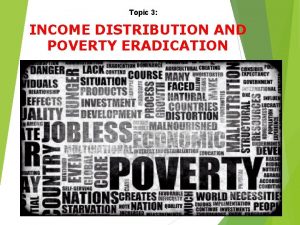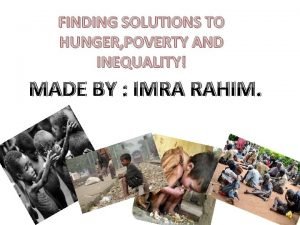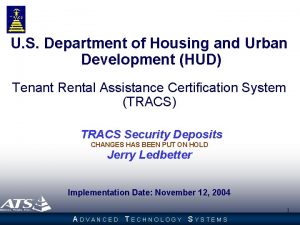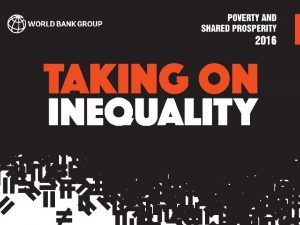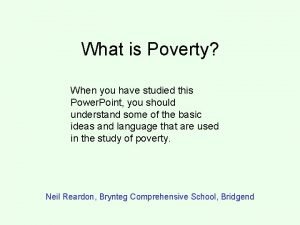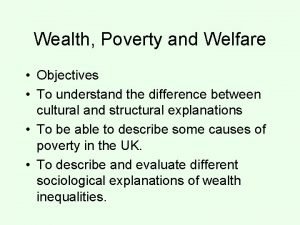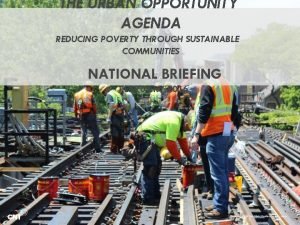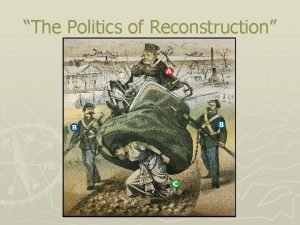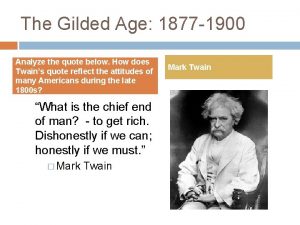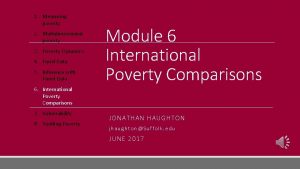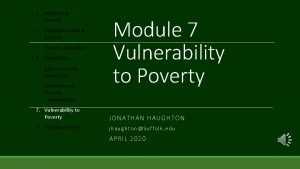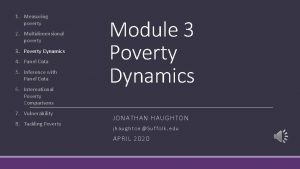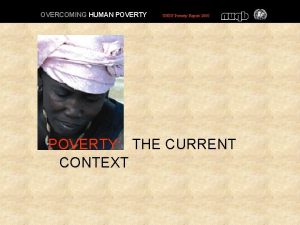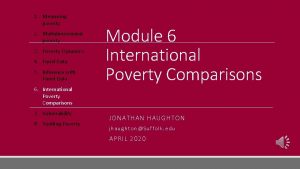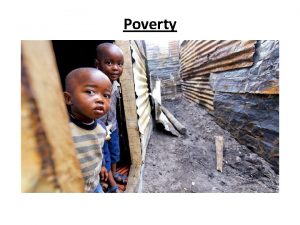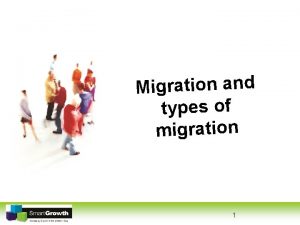Poverty Drugs and Migration Drugs Migration and Poverty
















- Slides: 16

Poverty Drugs and Migration

Drugs, Migration and Poverty Latin America is a diverse region that is rich in culture and heritage. However, there are social, economic, and political issues within the region that have had a negative impact on its development. Such issues include a high poverty rate, a lack of a strong educational system, as well as few jobs and industries make it difficult for many people in Latin America to thrive financially. Another factor that negatively influences the development is the war on drugs. Unfortunately some people in Latin America turn to the production and distribution of illegal drugs to make money. The war on drugs is not only illegal, but it is dangerous and has led to the deaths of millions of people in Latin America! Corruption by the police and politicians who are not doing enough to stop dangerous cartels is also a major problem. Discouraged by the limited opportunities for jobs and education, as well as the war on drugs and corruption of government officials, many in Latin America have emigrated to the United States in search for a better life.

Drugs, Migration and Poverty • 1. List the push factors on why people want to leave Latin America: • 2. List the pull factors on why people would want to emigrate to the United States: • 3. Draw a cartoon with at least 3 panels that summarizes how drugs, migration, and poverty are connected.

War on drugs • The War on Drugs is a phrase used to refer to a government-led plan that aims to stop illegal drug use and drug trafficking (selling of drugs) by increasing and enforcing penalties for people who buy and sell drugs. The movement started in 1971 with President Richard Nixon and is still evolving today. Nixon went on to create the Drug Enforcement Administration (DEA) in 1973. The effort by the U. S. government to eliminate the supply of drugs has also been called the “Supply Side War. ” The logic behind the strategy is rather straightforward: if there are no drugs, then no-one will use them. Since the 1970’s, the U. S has spent more than a trillion dollars attempting to dismantle drug cartels in Latin America.

War on Drugs Pros: - People who sell drugs are punished and go to jail. - Decreases crime because drug addicts are now put into jail, preventing them from doing harmful things to other people. - People will not want to do drugs because of fear of going to jail. Cons: - Making drugs illegal only makes the act of selling drugs criminal and more dangerous. - A lot of citizen’s tax money is spent on stopping the sell/use of drugs instead of improving schools, roads, etc. - Criminalizes drug users instead of helping them. - Police are put into danger by having to go after people selling drugs. • https: //www. youtube. com/watch? v=jt. Za. WLOSi. WA

War on Drugs • Discuss with your group if you think the war on drugs has worked or failedexplain your reasoning. Then, imagine you are the President of the United States, and in a paragraph explain what policies you would put into place to stop people from buying and selling drugs.

Migration 1 • The United States has been the top destination for international emigrants since at least 1960, with one out of five of the world’s emigrants living here as of 2017. However, not everyone enters/lives in the Untied States legally. An illegal immigrant is somebody who illegally enters a country and takes up residence. There is estimated to be 11 million people living in America illegally. Many of these people come from Latin America looking for a better life and more financial opportunities. There are many negative stereotypes of illegal immigrants being criminals and/or stealing American jobs. But illegal immigrants have much to offer and even are important to the U. S. economy, as well as vital to certain industries like agriculture where about half of the hired workers employed in U. S. crop agriculture were undocumented/ illegal immigrants. Illegal immigrants also helps Latin America’s economy because they are able to send some of the money they make back home which is called remittance. Remittances are one of Mexico's top sources of foreign income, outpacing oil exports which brought in 18. 5 million. Mexicans immigrants sent home $26. 1 billion!


Do the Math • 1. What is the ratio of immigrants that have been convicted of a crime? • 2. What is the ratio of immigrants that have been convicted of a felony? • 3. One out of three Americans have a criminal record. How does that compare to illegal immigrants?

Migration 1 • 4. Would you consider Europeans who colonized the Americas illegal immigrants. Defend your answer (2 -3 sentences) • 5. What do you think should be done with the illegal immigrants living today in the United States?

Migration 2 • The smuggling of migrants is a truly global concern, with a large number of countries around the world affected. In Latin America, coyotajes are profit-seeking criminals who smuggle people across the Mexican border into the United States. Coyotajes take advantage of the large number of people willing to take risks in search of a better life when they cannot access legal channels of migration. Smuggled migrants are vulnerable to abuse. Their safety and even their lives are often put at risk: they may suffocate in containers, perish in deserts or drown at sea while being smuggled by profit-seeking criminals who treat them as goods.

• Migrants are paying anywhere from $4, 000 to $10, 000 each for the illegal journey to coyotajes!!!

Migration 2 • 1. What states border Mexico? • 2. What are the top 3 states with the highest Hispanic population? • http: //www. pewhispanic. org/2016/09/08/4 ranking-the-latino-population-in-the-states/ 3. Do you think that the United States should build a physical barrier like a wall at it’s southern border? Defend your answer (2 -3 sentences)

Poverty • One out of five Latin Americans live in poverty. That’s an astounding 130 million people! Poverty rates vary from country to country in the Latin American region. With estimated poverty rates floating around 10 % in Uruguay, Argentina and Chile which have the lowest poverty rates. Meanwhile, Nicaragua with 37 % and Guatemala with 50 % have the highest poverty rates in Latin America. Poor Latin Americans lack access to basic health care services, clean drinking water and sanitation (toilets/sewage). The lack of education in Latin America lowers prospects of rising out of poverty. One in 12 young people ages 15 to 24 have not completed primary school, and therefore lack the skills necessary to find decent jobs which keeps them poor and in poverty. 25 % of Latin Americans are living on under $4 a day and 14 % of the Latin American population is living on only $2. 50 a day!

Poverty • Some 111 million Latin Americans (out of a total of 588 million) live in shanty towns. Shanty towns are located on the outskirts of town where you have housing for the poor which is made of plywood, uneven metal sheets, plastic, and cardboard boxes. Rocinha • Largest shanty town in Rio de Janeiro, Brazil

Poverty • 1. Look at the cost of living in Rio De Janeiro and calculate how much money you would need to make to pay rent, buy groceries, transportation, clothing, etc. for a month. https: //www. numbeo. com/cost-of-living/in/Rio-De-Janeiro • 2. Imagine that you are a poor Brazilian living in the shanty town of Rochina. Write a diary/journal entry about what you think you have to do to get out of poverty.
 What is absolute poverty
What is absolute poverty Relative and absolute poverty
Relative and absolute poverty Poverty and delinquency
Poverty and delinquency Sandra cisneros bio
Sandra cisneros bio St john chrysostom on wealth and poverty pdf
St john chrysostom on wealth and poverty pdf Poverty and hunger solutions
Poverty and hunger solutions Symbolic interactionism and poverty
Symbolic interactionism and poverty Ministry of housing and urban poverty alleviation
Ministry of housing and urban poverty alleviation Inequality and poverty
Inequality and poverty Greed and poverty
Greed and poverty What is poverty
What is poverty Structural poverty
Structural poverty Oscar lewis theory
Oscar lewis theory Ways to reduce poverty
Ways to reduce poverty Sharecropper cycle of poverty
Sharecropper cycle of poverty Hidden rules of poverty
Hidden rules of poverty Quotes about the gilded age
Quotes about the gilded age
